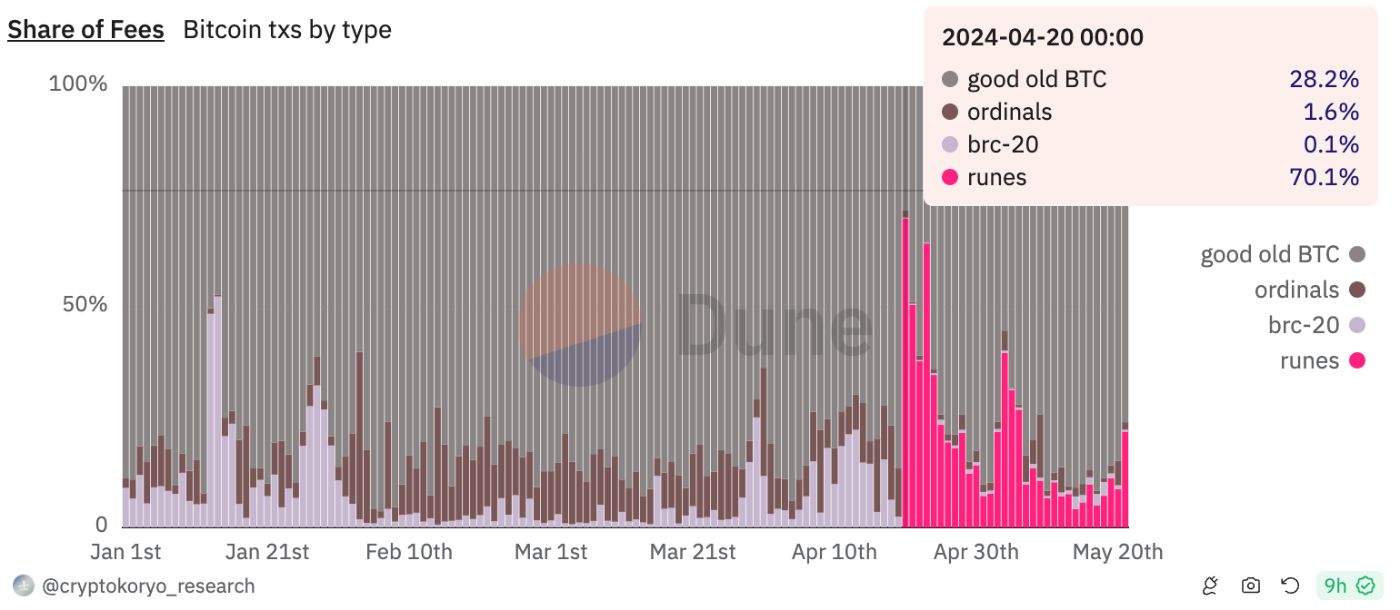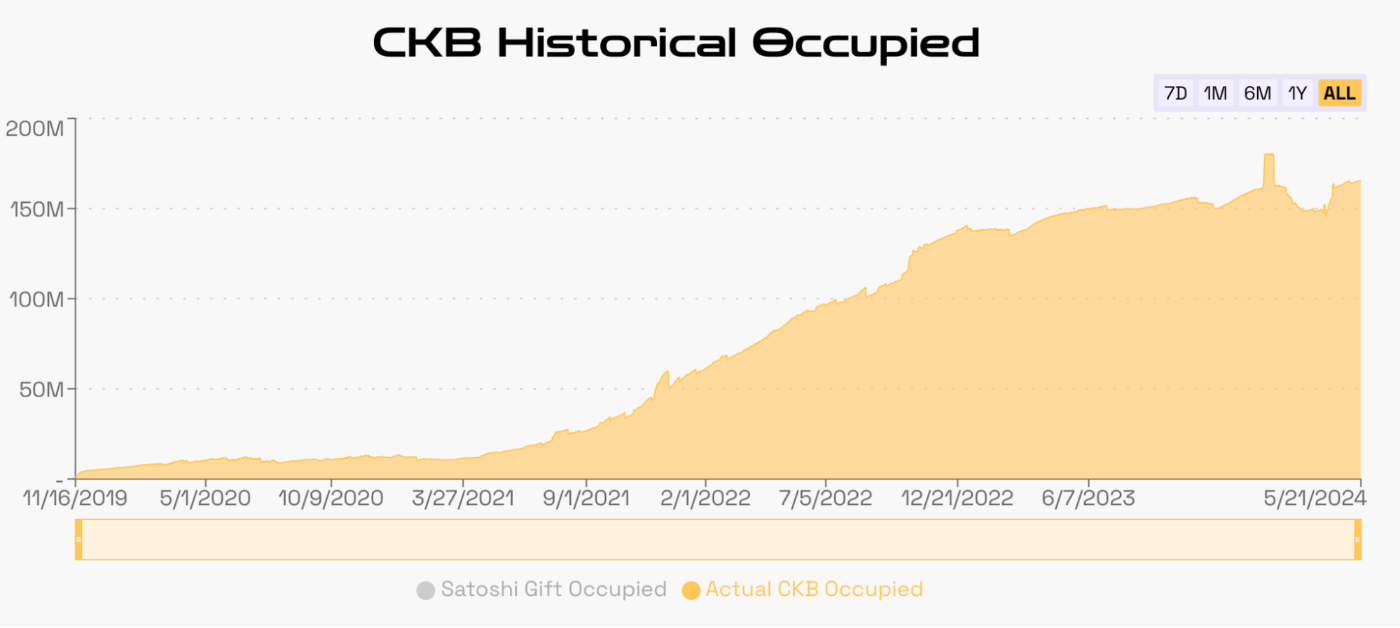Bitcoin’s recent innovations such as inscriptions and Runes are gradually becoming the focus of the crypto industry's attention. This is because they have been showcasing the different application potential of UTXOs (Unspent Transaction Output) through the Ordinals protocol, Nervos CKB, and others. They follow a Bitcoin UTXO model which emerged as industry competition intensified and technology advanced, enabling applications to be built on the Bitcoin network and share security with its main chain naturally.
This article is the summary of
Bitcoin UTXO model
With the model, the circulation of every satoshi (sats i.e. the smallest unit of Bitcoin) of a BTC is traceable and non-fungible (perhaps the earliest form of NFT). It provided a foundation for developing the Ordinals protocol and the BRC-20 ecosystem which saw Bitcoin developer, Casey Rodarmor, release an open-source software called ORD on a Bitcoin Core full node in December 2022. The software allows users to input any information, such as a string of text or an image, into the Bitcoin blockchain, and then bind this uploaded information to a specific satoshi. This ultimately created the possibility of a satoshi being stored with information, also known as a Bitcoin NFT.
The Ordinals protocol has two parts: Ordinals and Inscription. Ordinals serializes satoshis (1 BTC = 100,000,000 sats) and allows the tracking and transferring of individual satoshis. Once numbered, content can be written into the transaction's "Segregated Witness (SegWit) area" and assigned to the first satoshi of the transaction output. Inscription is the content stored in sats, which could be images, text, audio/video, or even codes, provided they do not exceed the 4MB limit of a Bitcoin block.
The Ordinals protocol can not only be used to issue NFTs but tokens too. Such is the development of new asset protocols like BRC-20 and applications like Runes. BRC-20 originated from a community experiment after a Twitter (X) user, Domodata who believes that the Ordinals protocol can be used not only to issue NFTs but tokens as well when Inscriptions are attached in JSON data format. He published what he called "an interesting and experimental standard" known as BRC-20 on GitBook, based on the Ordinals protocol, and showed that the standard allows Inscriptions to be set in JSON data format to deploy mint, and transfer tokens. Transactions on the Bitcoin blockchain have since accounted for a significant proportion after BRC-20’s emergence.

The BRC-20 standard has rapidly promoted the development of Inscriptions, as the potential of Bitcoin blocks and UTXO has rarely been deeply explored. This is an interesting experiment based on Bitcoin UTXO, which has been embraced by the community and users.

Source:
UTXO Potential Raises Expectation on the Bitcoin L2 Ecosystem
As many active on-chain transactions were recorded, the foundation for tapping the UTXO model’s potential to build applications was laid in 2023. The model has since created heightened expectations in the market and continues building an ecological model that differs from Ethereum's Layer 2 (L2) which is also eagerly awaited by the market.
From the ERC20 standard that led to initial coin offerings (ICOs) to the development of Automated Market Makers (AMMs) that energized DeFi, and the emergence of NFTs and the metaverse, Ethereum’s ecosystem has gradually become richer through fraught with twists and turns. Meanwhile, as Ethereum's L2 has developed rapidly in recent years and the overall control of Ethereum's on-chain gas fees has been achieved amid a thriving ecosystem, the nascent Bitcoin L2 ecosystem has started receiving significant market attention particularly relating to the strong market expectation for UTXO potentials.
Bitcoin might not have the smart contract capabilities of Ethereum but the UTXO model being able to distinguish every satoshi of Bitcoin promises an ecosystem different from Ethereum's. It also differs in the sense that outputs created by Bitcoin transactions are not simply public key addresses but scripts. That is, the BTC in a UTXO is not recorded in someone's account as a balance—each transaction initiator creates a lock for these BTCs through a script, and only the owner has the key. A key benefit of this approach is that it allows all transfer transactions to be viewed from the perspective of BTC circulation, and different UTXOs can undergo parallel transactions, as UTXOs are strictly distinguished from each other. With each satoshi being stamped every time it transfers, the UTXO mechanism completely records the transfer history of all parts of BTC.
The expectation has been further enhanced by the Taproot upgrade which, as the most significant upgrade since the activation of Segregated Witness (SegWit), aims to improve the Bitcoin network's privacy and efficiency. Taproot’s most notable change is allowing multiple complex signatures (such as multisig wallets) to be aggregated and verified collectively rather than separately. The aggregated signatures make the network perform faster, cost less, and save block space. Taproot provides a new way to execute Bitcoin transactions by enhancing user privacy and flexibility greatly improving Bitcoin's scalability.

UTXO-based BTC L2 is Expected to Foster a New Ecosystem
The emergence of the Ordinals protocol, inscriptions, and Runes has further improved the Bitcoin ecosystem. As of May 6, the total value locked (TVL) of the Ethereum ecosystem exceeded $96 billion while the Bitcoin ecosystem grew its TVL by $1.2 billion in the past year. Undoubtedly, compared with Ethereum, the development of the Bitcoin ecosystem is still in its early stages.
Without the smart contract capabilities of Ethereum, Bitcoin is following its different technical routes to explore new possibilities for UTXO. One such is Bitcoin's L2 networks that use state channels (such as the Lightning Network), sidechains, Rollups, etc., mostly relying on L2 to extend smart contract capabilities. Since Bitcoin's main chain would have to be bridged with an L2 in such instances as a type of sidechain in a cross-chain manner to achieve consensus and shared security, interacting with Bitcoin's UTXO model is an unavoidable step.
Naturally, asset protocols for fungible tokens (FT) will also become a new direction. At 8:09 on April 20, 2024, BTC completed its fourth halving at block height 840000, reducing the mining reward for each block from 6.25 BTC to 3.125 BTC. At the same time, Bitcoin Runes were officially launched at block height 840000. Runes are an improvement on Inscriptions, allowing for more flexible and direct deployment of assets within Bitcoin UTXO, akin to an etching technique as expressed by the Chinese term "Runes." The Runes protocol deploys token assets’ directly recorded information onto the Bitcoin chain: written into the OP-RETURN field of Bitcoin UTXO.
The launch of Runes immediately drove a rapid increase in on-chain fees for Bitcoin. Since its launch on April 20, on-chain fees generated by Runes activities that day accounted for 70.1% of total Bitcoin on-chain fees, a clear distinction from traditional Bitcoin transfers which has previously been the primary source. For block 840000, the fees generated were 37.626BTC, more than ten times the mining reward (3.125BTC). This has been highly sought after by the market.

Runes have made further improvements in design, issuance, and compatibility, preparing for compatibility with fungible tokens, and interfacing with bridges, and DeFi applications.
The Evolution of UTXO: Nervos (CKB) Cell Model
Meanwhile, despite the expectations that ecosystem applications are to have from the UTXO model, and the unique development potential of the Bitcoin L2 ecosystem, Bitcoin not using the familiar account model to represent the flow of Bitcoin transactions remains a challenge.
A scenario in point is when a user receives 100 BTC from another user to form a 100 BTC UTXO. It’s like putting and locking the 100 BTC in a box with a key that only the user's private key can unlock. In reality, these 100 BTC may be composed of other locked UTXO boxes (e.g. four 25 BTC UTXO boxes, or other combinations). When that is the case, each operation results in a Bitcoin unspent output (UTXO) since it can only store the "contained" value of its BTC and cannot store more data or have more scalability. This is unlike the account model which simply updates the state of the balance.
Nervos CKB inherits Bitcoin's UTXO architecture and has created the Cell Model—a generalized UTXO model for state storage that maintains UTXO’s simplicity and consistency. With CKB, all states are stored in cells while computations are done off-chain, and nodes perform transaction verification to and publish on-chain. Inspired by the Bitcoin UTXO model, the Cell model defines the behavior of each Cell within Nervos CKB and the process of updating the data it contains.
Like Bitcoin UTXO, a Cell is immutable once formed: once Cells are added to the chain, no changes can be made. Updating the data within a Cell requires a process called "spending"—similar to how Bitcoin UTXO transfers are implemented by "spending." This involves using the updated data to create a new Cell, and then adding it to the chain—similar to the formation of a new Bitcoin UTXO (for the spent output). Likewise, each Cell can only be spent once.
Unlike Bitcoin's UTXO, a Cell can contain various data types, such as CKBytes, tokens, JavaScript code, or JSON strings, which broadens the capabilities of Cells, thus extending the potential of UTXO—for instance, enabling smart contracts (even customized ones, such as issuing NFTs, limiting token supply, and setting conditions to meet unique needs). Put another way, a Cell is like a smarter UTXO. That is, if Bitcoin's UTXO is a box holding a paper ledger, then a Cell is like replacing the paper ledger with an Excel spreadsheet.


It's important to note that the Cell model separates the computation and verification of smart contract execution. Computation occurs off-chain, generating new data, which is then verified on-chain by network nodes. In the Cell model, the execution of smart contracts is parallel, i.e., each transaction runs independently in its virtual machine, with multiple virtual machines running simultaneously. Transactions in the Cell model are highly flexible and efficient, allowing multiple smart contract operations to be batched into a single transaction, thus minimizing transaction and processing fees.

Source:
The aforementioned off-chain computation and on-chain consensus model is quite popular, such as the RGB protocol in BTC extension protocols, which involves off-chain computation and submits the consensus transaction results to the Bitcoin chain. This protocol is essentially similar to the Lightning Network. On this basis, the RGB++ protocol has been developed, utilizing one-time seals and client-side verification (CSV) technology to manage state changes and transaction verification. It isomorphically maps Bitcoin UTXOs to Nervos CKB's Cells, using the script constraints on the CKB chain and Bitcoin chain to verify the correctness of state computations and the validity of ownership changes—this benefits from seamlessly integrating UTXO's features between Bitcoin and Nervos CKB. RGB++ not only implements enhanced client-side validation, transaction folding, and shared state across contracts, but also introduces Turing-complete smart contract scalability and performance extensions to Bitcoin without the need for cross-chain transactions and without compromising security.
UTXO Uniqueness to Foster a Unique Bitcoin Ecosystem?
There was a time when Bitcoin's UTXO and Ethereum's ERC20 seemed to have a classical vs. modern difference. That is changing with Ordinals and Runes making asset deployment based on UTXO possible and Nervos CKB’s upgrade of UTXO further liberating computational power though they are still at their early stages. These developments hint at the unique potential applications of UTXO, which seem more interesting and have become a new expectation in the industry.
UTXO is both the root of Bitcoin's security and reliability (anti-double spending, traceability, etc.) and, due to scalability issues, limits the development of the Bitcoin ecosystem, which is still unable to reach the rich ecosystem scenarios of Ethereum's DeFi, NFT, and metaverse. However, its uniqueness stands to foster a new ecosystem going by Bitcoin's recent innovations receiving significant market attention as a bold indicator of market confidence for UTXO potential. With the fluctuating hype after the emergence of Runes and Ordinals, we believe that the characteristics of UTXO have the potential to inspire a different ecosystem paradigm, and we look forward to the early emergence of such a "stunning" paradigm soon.
Disclaimer
The development of blockchain technology and related projects is still in the early stages, with risks of not meeting expectations. The actual operation of blockchain and Web3 projects involves various financial, network, and other regulatory policies. Currently, regulatory policies in various countries are still in the research and exploration stage without a mature regulatory model, posing risks of regulatory uncertainty.
By Jiaji Song and Heyi Ren, Researchers at Guosheng Securities
